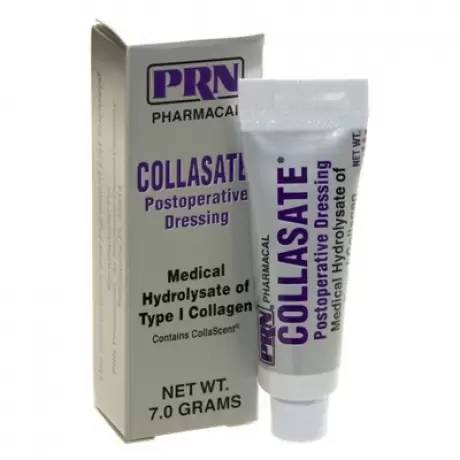
Collasate
Collasate
Collasate is currently unavailable.
Please check back with us at another time as we are uncertain when we will have more in stock.
What is Collasate for Dogs and Cats?
- Collasate products are designed to help wounds heal quickly and naturally.
- Collasate products contain Medical Hydrolysate of Type 1 Collagen.
- Unlike other collagen products, which are made from native collagen, Collasate's hydrolyzed collagen is a patented product available in amino acid form to be immediately utilized by the wound site for healing, helping speed recovery.
Why do cats and dogs use Collasate?
- Collasate Postoperative Dressing helps manage surgical sites, chronic wounds, and acute wounds. It can be used on partial and full-thickness wounds including surgical sites, dental extractions and oral surgery, pressure ulcers, venous stasis ulcers, ulcers resulting from arterial insufficiency, traumatic wounds, superficial wounds, first and second degree burns, spays, neutering, declawing, foot pad injuries, hot spots, diabetic ulcers, and lick granulomas.
What else should I know about Collasate?
- Medical grade gel form of collagen.
- Reduces pain, soothes, and deodorizes.
- Protects the wound and newly formed tissue.
- Does not require removal during dressing changes.
- Easy to handle and deliver.
- Biocompatible, biodegradable.
- Safe to use, non-toxic.
- Conforms to any wound site.
- Provides a physiologically favorable environment that encourages healing.
What problems could my dog or cat have with Collasate?
- If condition worsens or does not improve within 10 to 14 days, contact your veterinarian.
- Avoid allowing Collasate Spray to come into contact with the eyes as the Bitrex may cause eye irritation. Avoid contact with the mouth and nose, as the Bitrex is very bitter.
- Do not use Collasate Silver on animals with a known sensitivity to silver.
How do you use Collasate?
- Use as directed by your veterinarian.
- Manufacturer's suggested use: Clean the site. Apply directly to the wound and surrounding area. Allow to dry. Cover with a non-stick dressing.
What is in Collasate?
- Collasate Postoperative Dressing ingredients: Medical Hydrolysate of Type I Collagen.
Will I get what I see in the picture?
- Collasate is a brand name. You will receive the exact brand that you request.
Is it important for my dog or cat to finish all of the Collasate?
- Dogs and cats may use Collasate for different lengths of time. Please consult your veterinarian if you have any questions.
Review Summary
3 total reviews
Rated 5.00 out of 5 stars
100% of respondents would recommend this to a friend
Ratings Distribution
3 5 star reviews
0 4 star reviews
0 3 star reviews
0 2 star reviews
0 1 star reviews
Reviews
-
ER vet tech - love this product!
From UndisclosedComments about Collasate Silver Topical Dressing, 7g TubeThis is a great topical solution to areas with a lot of bleeding. The silver (nitrate) cauterizes, while the Collasate dressing itself does wonders for healing. Be advised, silver nitrate is not comfortable to apply, and is often painful for a moment. However, when needed, it is truly a lifesaver. -
-
100% satisfied
From undisclosedComments about CollasateThis helps expedite wound healing. Easy to use. -
Superior product
From Syracuse, NYComments about CollasateI used post-op after suture removal on my GSP, site opened to 2nd layer of sutures. I used this as directed and the total wound was clean and closed within 8-9 days after opening. Healing was from within.
Displaying Reviews 1 - 3
Q & A
-
How do I clean the collastate film off a wound??
-
According to the manufacturer, Collasate does not require removal during dressing changes. It is recommended that you consult with your veterinarian before using this product. Your veterinarian will be able to provide you with the best instructions for managing your pet’s wound care.
Verified Answer
-
-
My dog has stitches from TPLO surgery. Should I wait until stitches are removed before applying collastate or can I use immediately after surgery with stitches still in.?
-
Collasate is labeled for topical use in the management of surgical sites, chronic and acute wounds, and all partial and full-thickness wounds. According to the manufacturer, this product may be used with or without sutures. It is recommended that you consult with your veterinarian before using this product to determine if it best suits your dog’s needs.
Verified Answer
-
-
When it is applied to the wound area, should or can Collasate Postoperative Dressing be covered with a gauze pad or should it be exposed to the air??
-
You can cover with a non-sticky dressing (e.g. Telfa® pad) when the medication is dried.
Verified Answer
-
-
My male 4 year old Doberman pincher has the distal tip of his back paw nail exposed. Would collasate help heal the nail and would it be safe Thank you?
-
Pat, Collasate postoperative dressing is recommended by the manufacturer to help the healing process of general dermatologic wounds, declawing, and certain types of ulcers. The manufacturer doesn’t state any specifics regarding the use of broken nails. It appears to be safe to use but we recommend contacting your dog's veterinarian for further advice on how to appropriately take care of the nail. The exposure of the soft tissue (quick) may lead to infection. It is important to clean the area with a scent-free soap and to stop any bleeding with stypic powder or pencil. Wound dressing can help minimize the risk of infection as well. Thank you, VetRxDirect
Community Answer
-
Displaying Questions 1 - 4



